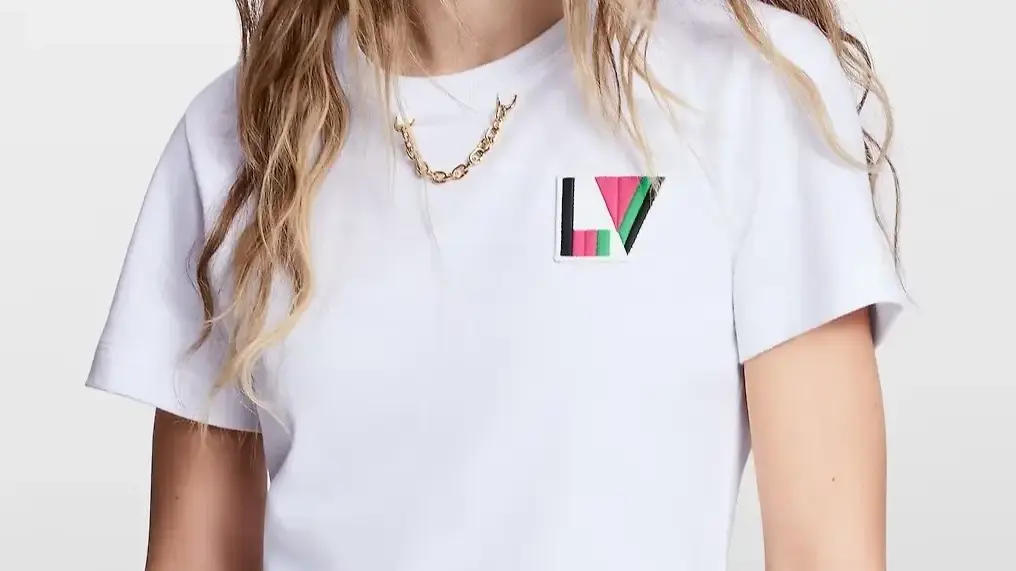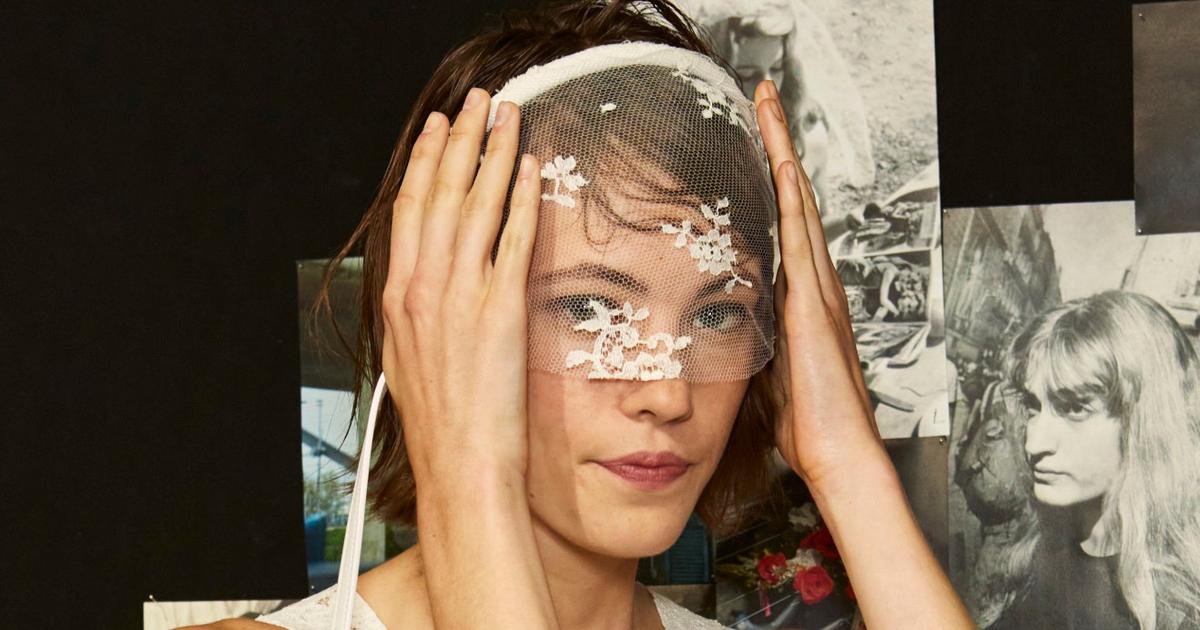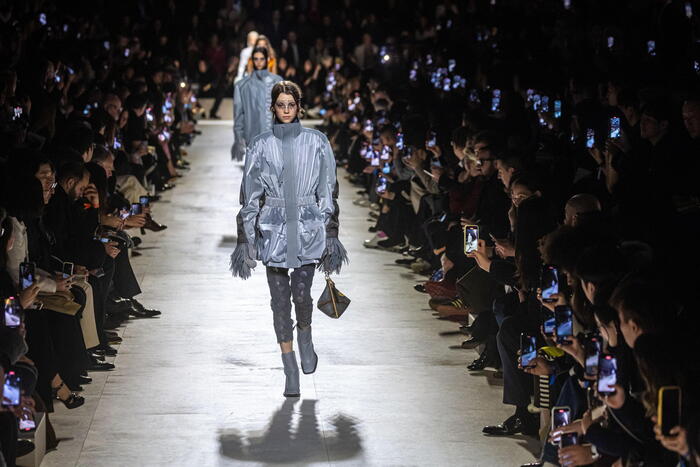The Blue Chair section: Shenkar fashion designer Orit Freilich: "Sweatshirt is a dynamic item, suitable for existential confusion" • How will the changes in fashion habits affect us?
Orit Freilich, who grew up in Bnei Brak, where does your affair with design and fashion actually begin? It was not a really acceptable occupation in the religious society in which you grew up.
"I was born in Haifa on the Carmel, and grew up in Bnei Brak. On the face of it, this is really not necessarily the classic place from which someone whose teachings are fashion will emerge. Fortunately, I did not encounter any opposition around me, and no one forbade me to engage in it. Realized this when at the age of 5 they bought me sandals in Bnei Brak and I decided to cut them and redesign.
Orit Freilich // Photo: Yehoshua Yosef
"At the same time, the holy books I studied in school - Mishnah, Torah, Halacha, Dinim - were mainly paintings of shoes, hairstyles, bags and clothes.
It flooded my imagination and in many ways it was even quite requested that I get into this field.
I was called the class painter.
I was exceptional in dress and demeanor, and tried to find my way between the paths without getting on barricades;
I found my self-expression in clothes. "
It can be said that the connection between religion and fashion began in the book of Genesis. In the past you described Adam and Eve as the first fashion designers.
" In the book of Genesis, after Adam and Eve ate from the tree of knowledge, their eyes were opened. them.
Then, their first action is 'they will sew a fig leaf and make them belts'.
In this sense, even a fashion designer produces clothing items that are needed.
After their expulsion from heaven, the following verse appears at the end of chapter three: 'And the Lord God made for Adam and for his wife coats of skins and clothed them.'
"This verse has bothered me for years. I understood it in such a way that the 'super designer', God, did not accept the leather belts that humans designed for themselves, and he decided to do it in his own way. I find a kind of struggle between divinity and humanity as to the proper type of garment. "There is an impression that this is a struggle that will never end."
You used to say that in the essence of the garment there is an unsolvable problem.
"It's exactly this struggle. But there's another element here - death. When a person dies, or his or her closest parents or relatives die, the act of mourning is performed by tearing a garment. The garment is our second skin, our covering. There is the skin we received, and when we mourn and someone The closest to us has died, Judaism indicates this by tearing a garment. There are elements in the garments that are not at all simple, it turns out.
"The word garment is also interesting.
It contains the root betrayal, from which the word 'betrayal' can be formed.
There is something about a garment that can also betray a person in a certain way.
For example, when in certain situations the garment no longer performs the purpose for which it was intended, which is no longer in one fit with the person, when suddenly it does not feel good inside.
This issue is charged;
Clothes are a world and a whole. "
HERMES For anyone who demands
such a situation, in which the garment no longer performs the purpose for which it was intended, brings the human race to buy, change and renew its garments constantly. Where do you think this instinct comes from?
" Ever in the industrial revolution , From the mid-18th century, we have been taught that consumption is important.
That it's one of the main things that drives the world.
During this period began to move beyond the cities, more factories were established, urbanization began and people left the villages and moved to the city, where they could find work and earn money.
Roads were paved, the 'production line' was born, and the market was characterized by goods that had to be sold and bought in order to have capital.
And we can say that we were educated for consumption - because suddenly we humans will have more free time.
"Before the Industrial Revolution - who had the money to dress? Only aristocrats. Many people worked in the fields and most people had very few clothes in their entire lives, which were also inherited. Because of the cold, women wore some skirts that replaced their degree of closeness to the body. Leisure did not exist. "
Even now, in Corona, the concept of "leisure" has become controversial.
Work and leisure time have become confused and have become almost symbiotic concepts, and this symbiosis seems to affect the way we dress.
Many of us started dressing up in sweatpants.
"It's the most comfortable garment in the world, so you can fall asleep with it in an armchair without noticing, for example. The sweatshirt fits exactly to the existential confusion Corona has created between leisure, home and work. Everything has confused us, and the sweatshirt is a dynamic clothing item that can support the dynamic environment created here In the last year.This comfort of training is also related to the fact that people have started to place comfort as a top value, and not necessarily the ideal of beauty, a painful concept in itself.
"Beyond that, I'm glad those companies that sell training have benefited and not had to close.
Because in a broader perspective, in central London, for example, out of 264 stores in the center of Oxford Street - 57 closed.
It's almost a quarter.
And after the plague, imagine the most active area in London with so many shops closed;
Who will fill them? "
What to do?
"The solution comes from city planners - in the form of producing hybrid quarters that combine big fashion stores, like Louis Vuitton and Hermes, along with museums and cafes. These quarters may make people come and shop because they create a lighter and more accessible atmosphere."
What items are people looking for in this period?
"This is not entirely clear, because a significant part of the public does not make money, and those who make a lot of money even in times of crisis are not necessarily the benchmark. Hermes' bags, for example, continue to sell insanely. Hermes reported a 6.9% increase in sales. $ 1.8 billion in the third quarter of 2020. And it should be understood, when buying a Hermes portfolio, one pays and sometimes waits three years to receive it.
“People with a lot of money will continue to buy according to their reach.
I hope that the crisis will allow a good quality of life for people without means, because we have often seen growth at the end of crises.
You could say that the two great fashion revolutions of the 20th century came after the First and Second World Wars.
Thus, for example, the fashion fluctuations mainly affected women's clothing: they left their skirts and went to wear pants, because the men went to war and the women manned their jobs. "
If we go back to the present day, what will happen after the corona to the fashions of fast fashion chains like Zara and H&M "The corona has caused them to drop revenues and close branches.
" This is where the world of sustainability comes into the picture, and H&M is one of the main supporters of this process.
As early as 2014, when I visited Copenhagen at the CFS International Conference on Sustainability, I saw clothes made at H&M based on clothes, zippers and reused buttons.
They sort the items, catalog them, and then the design team reuses them.
Their latest shows have a line called Conscious, Awareness, and they have recently released some awfully cool models.
They have set a goal that by 2030 the carbon footprint of the company around the world will be significantly reduced. "
We also recognize a certain trend of buying used clothes.
" I believe the younger generation understands that it is better to buy one used Louis Vuitton item, or Hermes, than a pile of cheap clothes or Alternatively a new outfit.
It permeates.
If we focus on Louis Vuitton - of course these are not items made from the same materials everywhere, like T-shirts.
When you buy a leather jacket or bag there - you know masters worked on it.
These are work traditions of years and years. "
On the other hand, it can be said that anyone who wants to help the environment - will not buy at all.
" In the fashion design department at Shenkar, headed by Ilan Beja, I teach a course called "Boot for Fashion", the products of which will be displayed in Dizengoff. Center on 2.3-24.2.
I formulated the course after the conference in Copenhagen.
Until then I knew what recycling was, and there I learned what sustainability is.
I realized that there is a mine here around which we revolve in the fashion world: we are busy producing beauty and image, and in the process many clothes are left aside, and at some point they already become ‘out of fashion’.
"At the same time, on that visit, I stood for two minutes in silence in memory of those killed in the collapse of a building in Bangladesh in 2013, which was loaded with heavy machinery, including sewing machines and lots of rolls of cloth and clothes. More than 1,000 people were killed there and it seemed abnormal to me. Buy clothes for a year. Nothing. "
Oh-oh.
Not an easy task.
"And I'm addicted. There's no way I'm not buying at a bazaar, for example. But I said to myself - 'You are not buying.' In view of the sustainability course I planned to teach at Shenkar I had to be a handsome demanding - handsome performer. Two trips to London and the US.
Admits and confesses that in one case I compromised on a second-hand purchase, in which I knew the money was going to aid weak populations.
As part of the course at Shenkar there is a project where the students create the coolest fashion there is from discarded clothes, from shamates.
This is the repair we make in the world using clothes. "
The fashion record at 15 shekels
Even today, after your spartan experiment, you said that you do not buy clothes, and make your clothes upcycling. Explain.
" I take the garment or fabric and upgrade it.
I have a dress, a piece of fabric that I bought in 2007 when it had an original print of ink stains and another huge stain, a real remnant of dirt, and it cost me exactly 15 shekels.
I made an opening in it in an unlikely place, redesigned it, and today I go with it to the most glittering events: international conferences, for example.
I lectured with her at a conference in Iceland and at the end of the lecture they kept asking me about this dress.
Every time I wear it it's like she was born yesterday.
It is timeless, despite the disappearance of the original stain. "
You've been using it for close to 15 years.
What will happen to her in 10-5 years?
"I think she's still going to have her statement."
Does sustainability in fashion help the Israeli crisis in the field?
"Those who want to continue to be fashionable will continue to buy fast fashion; but for those who have choice and awareness, I expect them to think twice. Do not take off entire shelves so as not to do anything with them. In general, I do not see the fashion world in the country running and embracing the sustainable world. Unfortunately, that is not happening yet. "
So what will happen in the country?
Even before the corona it was difficult here.
"I'm not optimistic at all. I was a designer in the '90s and I saw what happened to the fashion world. We produced here in the country and because the country abandoned the fashion industry completely, and let clothing importers like Zara come in here, the local fashion industry collapsed. Now, almost nothing is produced here. "Except for people like Doreen Frankfurt, and congratulations to her. If there is no government action, alongside a significant lobby, and students who come out of places like Shankar and become ambassadors - there will be a very big problem here."
I think of your wording - "a very big problem".
On second thought, maybe there's something insensitive about talking about fashion, which is considered a luxury after all, when there are so many unemployed out there?
"On the one hand you are right, and I say this with a heavy heart. On the other hand, people want to look good, even when they are unemployed, which is why fast fashion should survive. And as we know, we are a judicial society, which tends to judge people by their appearance, not necessarily by The content. It's awful to me, but it's the reality.
"Everyone's right to feel good, to look good, and that's a value that should be instilled at the educational level from an early age.
Sustainable fashion is also a value, because it is based on values.
She respects not only the wearer of the clothes but also the maker of the clothes - he deserves a wage, fair social conditions, that his children will have the opportunity to live adequately.
Sustainable fashion is a fashion that looks at the environment, not just itself, and of course it comes with education to speak.
There is no doubt that on this issue someone else still needs to lift the glove here.
We'll see who it will be. "
Finally, it is impossible without a word about the masks that have become the order of the hour.
Will they have a historical mention in the official history of fashion?
"Even in the Spanish flu, people wore masks, but there was not really a fashionable historical mention left behind. The younger generation, Generation Z and below, will in my opinion want to throw the masks to the winds. It disrupted their daily life in such a way that I think they will quickly forget. "I'm not willing to put on any mask that is not the simplest there is. I will not glorify something that leads to death and disease."
For suggestions and comments: Ranp@israelhayom.co.il











/cloudfront-eu-central-1.images.arcpublishing.com/prisa/KMEYMJKESBAZBE4MRBAM4TGHIQ.jpg)



